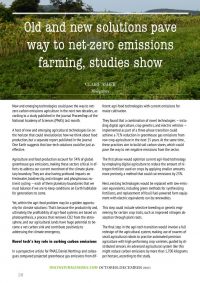 New and emerging technologies could pave the way to net-zero carbon emissions agriculture in the next two decades, according to a study published in the journal Proceedings of the National Academy of Sciences (PNAS) last month. A host of new and emerging agricultural technologies lie on the horizon that could revolutionize how we think about food production, but a separate report published in the journal One Earth suggests that low-tech solutions could be just as effective. Agriculture and food production account for 34% of global greenhouse gas emissions, making these sectors critical in efforts to address our current overshoot of the climate planetary boundary. They are also having profound impacts on freshwater, biodiversity, and nitrogen and phosphorous nutrient cycling — each of them planetary boundaries that we must balance if we are to keep conditions on Earth habitable for generations to come. Yet, within the agri-food problem may lie a golden opportunity for climate solutions: That’s because the productivity and, ultimately, the profitability of agri-food systems are based on photosynthesis, a process that removes CO2 from the atmosphere, and our agricultural lands have huge potential to become a net carbon sink and contribute positively to addressing the climate emergency.
New and emerging technologies could pave the way to net-zero carbon emissions agriculture in the next two decades, according to a study published in the journal Proceedings of the National Academy of Sciences (PNAS) last month. A host of new and emerging agricultural technologies lie on the horizon that could revolutionize how we think about food production, but a separate report published in the journal One Earth suggests that low-tech solutions could be just as effective. Agriculture and food production account for 34% of global greenhouse gas emissions, making these sectors critical in efforts to address our current overshoot of the climate planetary boundary. They are also having profound impacts on freshwater, biodiversity, and nitrogen and phosphorous nutrient cycling — each of them planetary boundaries that we must balance if we are to keep conditions on Earth habitable for generations to come. Yet, within the agri-food problem may lie a golden opportunity for climate solutions: That’s because the productivity and, ultimately, the profitability of agri-food systems are based on photosynthesis, a process that removes CO2 from the atmosphere, and our agricultural lands have huge potential to become a net carbon sink and contribute positively to addressing the climate emergency.
Novel tech’s key role in curbing carbon emissions
In a perspective article for PNAS, Daniel Northrup and colleagues compared projected greenhouse gas emissions from different agri-food technologies with current emissions for maize cultivation. They found that a combination of novel technologies — including digital agriculture, crop genetics, and electric vehicles — implemented as part of a three-phase transition could achieve a 71% reduction in greenhouse gas emissions from row-crop agriculture in the next 15 years. At the same time, these practices aim to build soil carbon stores, which could pave the way to net negative emissions from the sector. The first phase would optimize current agri-food technology by employing digital agriculture to reduce the amount of nitrogen fertilizer used on crops by applying smaller amounts more precisely, a method that could cut emissions by 23%. Next, existing technologies would be replaced with low-emission equivalents, including green methods for synthesizing fertilizers, and replacement of fossil fuel-powered farm equipment with electric equivalents run by renewables. This step could include selective breeding or genetic engineering for certain crop traits, such as improved nitrogen absorption through plant roots.
The final step in the agri-tech transition would involve a full redesign of the agricultural system, making use of swarms of small agricultural robots to practice automated precision agriculture with high-performing crop varieties, guided by distributed sensors. An advanced agricultural system like this might reduce carbon emissions by more than 1,700 kilograms per hectare, according to the study. “The report focused on one of the most common cropping systems on the planet — high intensity maize — and worked out a pathway to dramatically decarbonize,” explained Northrup. He argued that high-tech solutions can speed humanity’s transition to more sustainable crop cultivation that maintains vital ecosystem services like carbon sequestration and water filtration. “Because these tools can comfortably operate within current agricultural markets, they are a great place to build trust and converge on sustainable [agricultural] solutions,” he said.
Livestock decarbonization solutions
But crops tell only half the story, defining half the problem and half the solution: 50% of agricultural emissions come from animal production, and new technologies can help here, too. In a separate study, also published in the journal PNAS, a team led by Arren Bar-Even at the Max Planck Institute of Molecular Plant Physiology in Germany investigated how microbial protein could be used to reduce the environmental footprint of meat production and offer a healthy, sustainable, vegan protein for human consumption at the same time. Microbes have been cultivated for protein production for both feed and food since the First World War, and a recent renaissance in the field has seen many companies developing microbial systems to produce this “single-cell protein” (SCP) as a source of animal feed, fish feed, and commercial food products. Typically, companies use methane or agriculturally grown sugars to cultivate bacteria intended for feed and food, but production of both substrates is associated with accompanying environmental impacts. However, the new study found that those impacts could be bypassed by single-cell protein cultivation powered by solar panels. This new technology, dubbed photovoltaic single-cell protein (PV-SCP), could achieve up to 10 times higher protein yield per unit of land than staple crops like soybeans, reducing greenhouse gas emissions from land conversion and synthetic fertilizers.
“Engineering [and] electrochemistry are very good at certain things, and biology is very good at other things, and if we take the best of both then we can unlock new possibilities that were not available before,” said study lead author Dorian Leger, now an intern at the European Space Agency. The process works like this: Electricity from a solar farm is channelled to an electrochemical unit, which uses CO2 captured from the atmosphere to produce an energy-rich growth medium for microbial protein, which can then be converted into animal feed or further purified as an edible protein for a variety of human foods. The resulting protein is highly nutritious and meets the recommendations of the U.N. Food and Agriculture Organization (FAO) for healthy amino acid composition, as well as being rich in B vitamins. The team modeled the energy efficiency of PV-SCP compared to staple crops and found that the technique could generate 1.2 kg of protein per square meter of land per year — 10 times more than the highest-yielding crop alternative, soy, which outputs 0.115 kg of protein per square meter per year on average. Rapid implementation of this technology could potentially mean the salvation of the Amazon rainforest and Cerrado savanna in Brazil, where vast areas of native vegetation are being converted to soy annually. “To put it mildly, plants’ photosynthetic machinery is mind-blowingly impressive, yet I’m not that surprised that human engineered systems can outperform them from an energy efficiency point of view,” said Leger. Microbes can direct most of their energy into producing protein, whereas crop plants, like soybean, must invest additional energy in root systems, leaves and other non-edible components, he explained. SCP also sidesteps an important trade-off faced by plants between photosynthesis and water loss, because microbes can be grown in closed vats where almost no water is lost due to evaporation. So the process protects another planetary boundary: our freshwater systems.
New focus on old, low-tech agricultural techniques
Despite a great deal of excitement, research and investment into novel agri-technologies, some experts say the same end goal could be achieved with existing, low-tech solutions. The key: closing the loop on the agricultural nitrogen cycle. Another new study, published in the journal One Earth, reports that by implementing three simple principles, Europe could feed its growing population, break its reliance on imported feed, and achieve a substantial reduction in greenhouse gas emissions. The three principles: reducing human consumption of animal products, implementing organic crop rotation systems, and reconnecting livestock and cropping systems via manure. “The surprise is that, with organic farming, without any synthetic fertilizer, by just reconnecting livestock and by adapting our diet to health standards, we can feed everybody,” said study lead author Gilles Billen, a biogeochemist and emeritus research director at the French National Center for Scientific Research (CNRS by its French acronym) in Paris. The researchers calculate that regionally appropriate crop rotation systems, directly linking crop cultivation to livestock, could meet the protein requirements for 600 million Europeans in 2050, when the population is expected to peak. “By making use of legumes — those plants able to fix atmospheric nitrogen into proteins in their roots — as the head of the crop rotations, you can bring lots of nitrogen naturally to the soil,” Billen said. Diverse crop rotations like these also reduce pests and diseases that thrive in the uniform conditions of agricultural monocultures, thereby reducing or eliminating the need for pesticides — addressing another planetary boundary, polluting novel entities.
It’s all about nitrogen
Rather than relying on new technology, Billen’s scenario would see a return to agricultural principles that were commonplace just a century ago, but which would now be boosted by modern agro-ecological know-how. Europe was then dominated by mixed crop and livestock farms, recycling livestock manure to fertilize a diverse rotation of crops, including nitrogen-fixing legumes like clover and alfalfa. Those old ways were exploded by the discovery of the Haber-Bosch chemical process in 1909, which uses high pressures and temperatures to extract nitrogen from the atmosphere — a technology that revolutionized agriculture by making cheap synthetic fertilizers readily available. By 2015, the Haber-Bosch process was feeding an estimated 44% of the world’s population. The catch: for every ton of nitrogen extracted, Haber-Bosch uses a ton of fossil fuels and releases 1.87 tons of CO2. This single industrial process is responsible for an estimated 1.2% of global greenhouse gas emissions. The irony is, after expending so much energy to process that nitrogen, much of it never makes it into our crops.
“The plant-soil interface is very inefficient in terms of how it deals with nitrogen; only 50% of the nitrogen we apply as fertilizers is ending up in our food,” explained Leger. The rest becomes pollution — washed into waterways where it can cause harmful algal blooms, or released from the soil back into the atmosphere. Here, it acts as a potent greenhouse gas, with 265 times the climate-warming potential of CO2. In fact, humanity’s abuse of the nitrogen cycle has already resulted in one of our worst overshoots of a planetary boundary. “Although often overlooked, our influence on the nitrogen cycle is much greater than the one we have on the carbon cycle, and this depends massively on how we produce our food,” said Silvio Matassa, postdoctoral researcher at the University of Naples in Italy and co-author on the PV-SCP study. “One of the most terrible consequences of the generalization of the use of Haber-Bosch nitrogen synthetic fertilizer is the fact that it made possible to completely disconnect cereal cultivation and livestock farming,” said Billen. As production was scaled up, farmers in the most fertile regions focused on cultivating highly productive cereal crops, pushing livestock farming to less fertile regions and to where it became necessary to import feed.
“That [agricultural specialization] leads to a terrible disfunctioning [because] you are not able to close the biogeochemical cycles,” he explained. By closely pairing livestock and crop cultivation in the modeling study’s 2050 scenario, Billen and colleagues were able to dramatically reduce reliance on synthetic nitrogen fertilizers in favor of manure and legumes, resulting in a 57% reduction in nitrogen emissions. Other sources of waste nitrogen could also be redirected toward agriculture. For example, wastewater purification plants are legally required to remove nitrogen to prevent it entering streams and rivers; once extracted, it is released back into the atmosphere as nitrogen and the greenhouse gas nitrous oxide. “That’s completely crazy, of course, because it’s the same nitrogen; you can reuse it as long as you want by simple systems and you don’t need this energetic input and you can avoid the associated greenhouse gas emissions,” Billen said. “That’s why it was completely obvious for us to integrate [recycling wastewater nitrogen] in our scenario.” Reusing the nitrogen filtered from domestic wastewater back into the industrial agricultural system could be an environmental and economic win-win, saving roughly 2 tons of fossil fuel for every ton of nitrogen recycled.
Originally published
by Mongabay
July 30,2021



